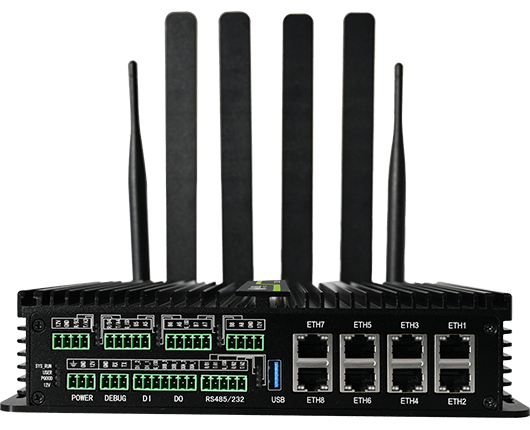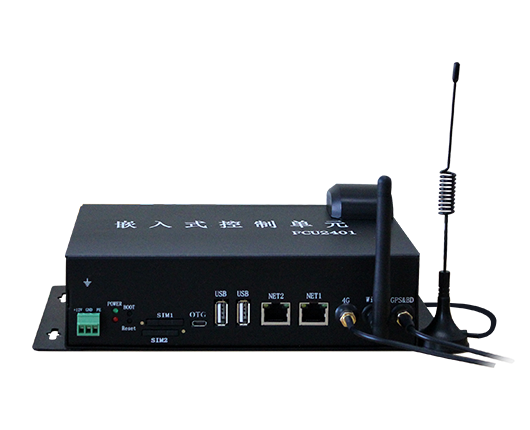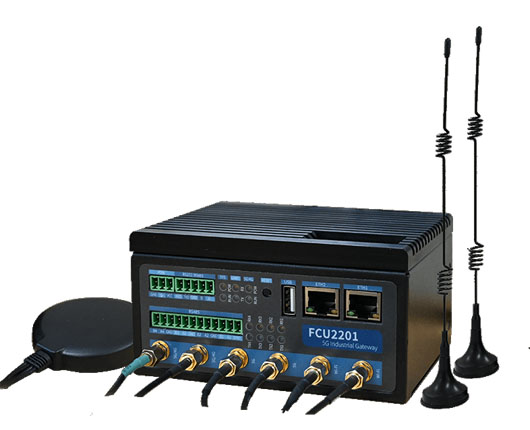
Unveiling the Power of Industrial IoT Gateways: Benefits, Cases, and Products
What is an Industrial Internet of Things Gateway?
As the number of IoT and industrial IoT devices continues to grow, so does the amount and speed of data being generated, so IoT gateways are needed to ease the pressure on cloud and data centers to accommodate, process, and analyze data.
Industrial IoT gateways are on-premises industrial computers that collect, store, process, and analyze data at the edge of the network, reducing the pressure on the cloud and data centers. IoT gateways typically collect data from sensors, devices, and machines. Once the IoT gateway collects data, it processes and analyzes the data, sending the processed data to the cloud for remote monitoring, remote control, and post-analysis.
Essentially, the Industrial Internet of Things gateway acts as a computer, allowing devices and sensors to communicate with each other and deliver information to the cloud. They are similar to routers in most homes, facilitating communication between devices and between devices and the Internet. However, IoT gateways are far more capable of processing, remembering, and storing capacity than sensory data.
Industrial data centers and IoT sensors with IoT advantages are deployed to reduce the burden on industrial data gateways. They can collect, filter, process, and analyze data locally without having to send all the raw data they collect to the cloud for processing and analysis.
By collecting and processing data locally, organizations deploying IoT gateways will see significant savings in Internet bandwidth because fewer raw data needs to be sent to the cloud. It is very beneficial for organizations to be a fee-paying Internet that pays for the bandwidth they use.
What are the benefits of the Industrial IoT Gateway?
Internet of Things and edge computing applications are typically deployed in extreme environments that involve wide temperatures, severe shocks, constant vibration, dust, and water exposure. To ensure a successful deployment, many applications require an industrial IoT gateway. Built into a small, low-power chassis, the Industrial IoT Gateway is ideal for compact remote IoT deployments. Here are some of the key features of some of the best industrial IoT gateways on the market.
1. Compact design
Fanless IoT gateways and rugged IoT gateways have a compact design that enables them to be deployed in space-constrained environments that are not large enough to accommodate full-size desktop computers. Compact design is made possible by passively cooling IoT gateway computers. Passive cooling makes a compact fanless design possible because it allows IoT gateway manufacturers to place components closer to each other and cool them by using radiators. The radiator is used to transfer heat from the internal heating components to the outer housing of the industrial gateway and then to dissipate the heat into the surrounding air.
2. Wide temperature design
Fanless Industrial IoT Gateways have a wide temperature range and operate from -40C to 85C for extremely cold and extremely hot environments.
3. Wide power design
To cover a wide range of applications from mobile to edge deployment, industrial IoT gateways are equipped with DC inputs in a wide voltage range from 9V to 50V. In addition, the IoT gateway is equipped with a number of power protection features, including overpressure protection, power surge protection, and anti-polarity protection.
Overvoltage protection shuts down the system when the device detects that the voltage rise exceeds the system's safety level. Surge protection transfers current to the ground when the device detects a voltage rise that exceeds the safe level. Power polarity protection prevents system power polarity reversal by cutting off the system power supply to avoid damage to sensitive internal components.
4. Anti-shock and anti-vibration
Fanless and rugged IoT gateways provide shock and vibration resistance, enabling them to be deployed in environments that are vulnerable to frequent shocks and vibrations. Rugged IoT gateway devices are able to handle shocks and vibrations thanks to their one-piece design, eliminating the number of connectors, screws and cables used in the system, making them more reliable and better able to handle shocks and vibrations due to the small number of active parts that can fail.
5. Industrial-grade component materials
Industrial IoT gateways are built from industrial-grade components, from housings to internal components such as power chokes, resistors, motherboards, I/O, and more. The housing of the Industrial Internet of Things Gateway is made of extruded aluminum, and heavy metal is molded into a single part of the housing. These additional steps help enhance the durability, reliability and service life of the equipment.
6. Energy efficiency
Industrial IoT gateways don't require a lot of effort to thank their energy-efficient buildings. The industrial IoT gateway is configured to use Intel's Celeron processor J1900 with a 10-watt low TDP (thermal design power consumption) designed with on-chip systems. This provides great flexibility for remote industrial deployments that require low-power IoT gateways.
7. Rich connection options
Industrial IoT gateways are equipped with a wide range of wireless connectivity features such as 5G/4G LTE, WiFi6, Bluetooth 5.0, and wired connectivity options such as RJ45 and M12 LAN with PoE Plus support. They also support traditional analog signals such as RS485, RS232, I2C, SPI, DIO, GPIO, and are mostly flexible for most communications.
What are the industrial IoT gateway cases?
Here are some examples of actual industrial IoT gateway deployments:
1. Intelligent agriculture
Industrial IoT gateways are used in smart agriculture to gather information and manage their deployment from IoT sensors, which are used to gather information such as weather conditions in crop environments, soil quality, and crop growth progress. All of this information is collected, processed, and analyzed by IoT gateways, providing farmers with valuable insights that enable them to make informed decisions about how much fertilizer is needed to make crops grow optimally and to improve other aspects of their operations to ensure optimal crop growth.
In addition, IoT gateways can be used to predict and forecast yields, enabling growers to better plan product distribution because they will have a fairly good estimate of the number of crops they will harvest. In addition, IoT gateways process and analyze large amounts of data collected by a variety of IoT sensors, enabling farmers to produce higher-quality crops.
The most popular IoT devices in smart agriculture include weather stations that use agricultural sensors all over the field to gather and analyze weather-related information for valuable insights on how to improve crops.
In addition, IoT devices and IoT gateways are typically used in greenhouses to gather real-time information about growing conditions, such as lighting, temperature, soil conditions, and humidity, enabling farmers to adjust conditions for optimal crop growth.
2. Intelligent traffic
IoT gateways are typically used to implement intelligent transportation systems. IoT gateways connect computers, electronic devices, and other sensors, as well as the cloud. The information collected by the IoT Gateway includes vehicle information, vehicle location, road information, and many other types of information to create real-time transportation systems that provide valuable insights into how to improve the performance of transportation systems.
For example, if an industrial computer predicts that a road is frequently closed or full at certain times of the day, the system can adjust the vehicle's route to avoid the vehicle, improving the efficiency of the system and saving valuable resources such as time and fuel. In addition, the data collected by the IoT gateway can be used for predictive maintenance.
That is, the IoT gateway can predict when a component or component of a transportation system will fail and alert the operator to maintenance or replacement before a failure or failure, eliminating any downtime associated with performing unexpected repairs.
3. Factory automation
Industrial IoT gateways are important in factory automation because they facilitate communication between dozens, hundreds, or thousands of IoT devices, factory machines, and factory devices, and between these devices and the cloud. The IoT Gateway enables remote monitoring of plant assets and control of those assets.
Industrial IoT gateways connect new machines that leverage modern protocols, as well as traditional machines that leverage old protocols. Protocols supported by IoT gateways include fieldbus protocols, PROFINET protocols, Ethernet/IP, and Ethernet CAT protocols. IoT gateways also collect information from these devices, process it, analyze it, and provide valuable insights that enable plant operators to maximize operational efficiency and minimize downtime through predictive maintenance of plant equipment.
4. Surface and underground mining
Industrial IoT gateways are also important, providing significant benefits to the mining industry, enabling mine operators to optimize mining processes and produce better results. IoT gateways are ideal for collecting, processing, and analyzing information collected through sensors and analyzing it in real time to allow operators to take the best action.
Deploy IoT devices for operators to improve the efficiency of data mining. In addition, IoT gateways enable predictive maintenance by predicting when components and vehicles will fail, enabling mine operators to perform preventive maintenance and reduce downtime due to unexpected vehicle failures.
In addition, IoT gateways can improve the security of mining employees. This is because IoT sensors can be connected to IoT gateways that monitor unstable areas of the mine and alert miners when the mine collapses or becomes extremely unstable.
What are the products for industrial IoT gateways?
1. FCU2201 Embedded Control Unit (industrial 5G industrial gateway, low power fanless design)
FCU2201 embedded control unit is equipped with NXP LS1012A network processor development design, is an industrial-grade cost-effective 5G gateway products, using fanless thermal design, CPU main frequency 1GHz, RAM512MB, to meet the general edge computing and data forwarding capabilities support for Ubuntu18.04 and OpenWRT systems for user-friendly secondary development design, 5G modules in M.2 package pluggable mode, can be replaced with 4G modules for cost optimization, and support 5 RS485 interfaces, 4 of which can be removed for cost optimization, products are suitable for smart factories, smart agriculture, smart cities, smart medicine and other fields, about sensor data acquisition, webcam image acquisition, data processing, storage, 5G upload and other applications.
2. FCU2303 Embedded Control Unit (5G industrial gateway, high performance, multi-interface, high bandwidth, large links, low latency)
FCU2303 embedded control unit is a highly integrated next-generation 5G intelligent communication gateway. Built-in up to four-core 1.8Ghz main frequency, high computing power CPU, with fanless design, provides powerful edge computing power while ensuring long-term stable operation of the system. All-Netcom 5G module can provide users with high broadband, low latency, large connection services. The control unit is equipped with gigabit Ethernet with 8 separate MAC addresses and 8 RS485s (of which 4 RS232/RS485 are reused). Widely used in smart cities, smart factories, smart power, smart water, smart agriculture, security monitoring and other industries. The software uses Ubuntu18.04 system to integrate a wealth of third-party components such as Samba, Lighttpd, virtualization technology (Docker, LXC, QEMU), IPSEC, OpenSSL, and more. Provide an open system API for secondary user development.
3. FCU2401 Embedded Control Unit (high-performance industrial gateway for charging piles, advertising screens, self-service terminals and other fields)
FCU2401 embedded control unit is based on the all-in-one A40i quad-core industrial processor design and development, main frequency 1.2Ghz, integrated MAli400MP2 GPU, memory 1GB (expandable to 2GB), eMMC storage 8GB. With a wide range of hardware peripheral support, including RS485, CAN, ESAM, USB, Ethernet port, 4G, WIFI, GPS, LVDS, HDMI, DI, DO, audio, SATA and other functional interfaces, communication peripherals in accordance with industrial product requirements all do isolation protection, testing through 4 levels of static testing; Support for dual-screen display, suitable for edge computing, charging piles, courier cabinets, advertising machines, new retail and other self-service terminal areas.





